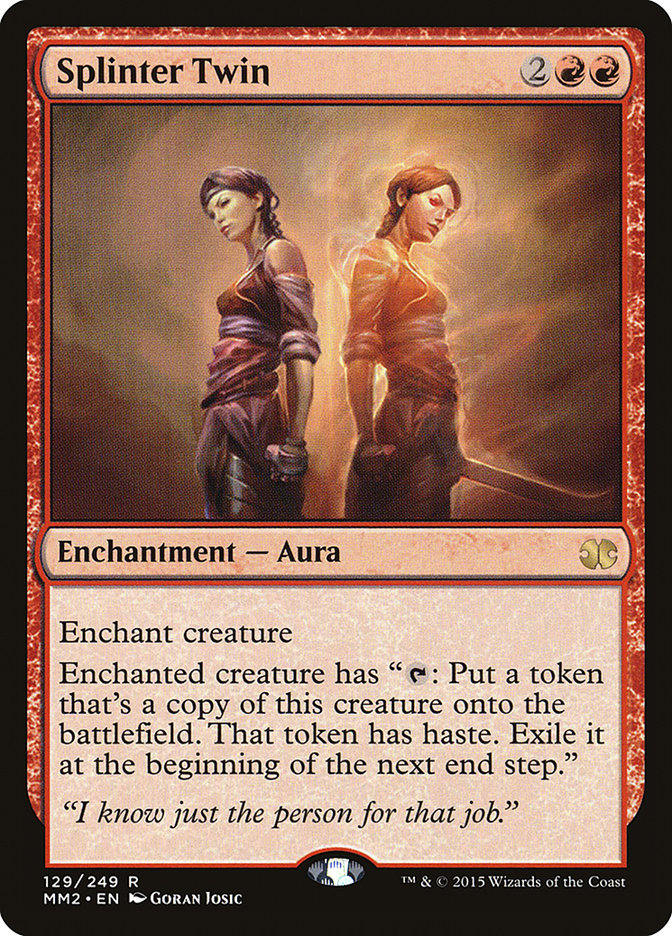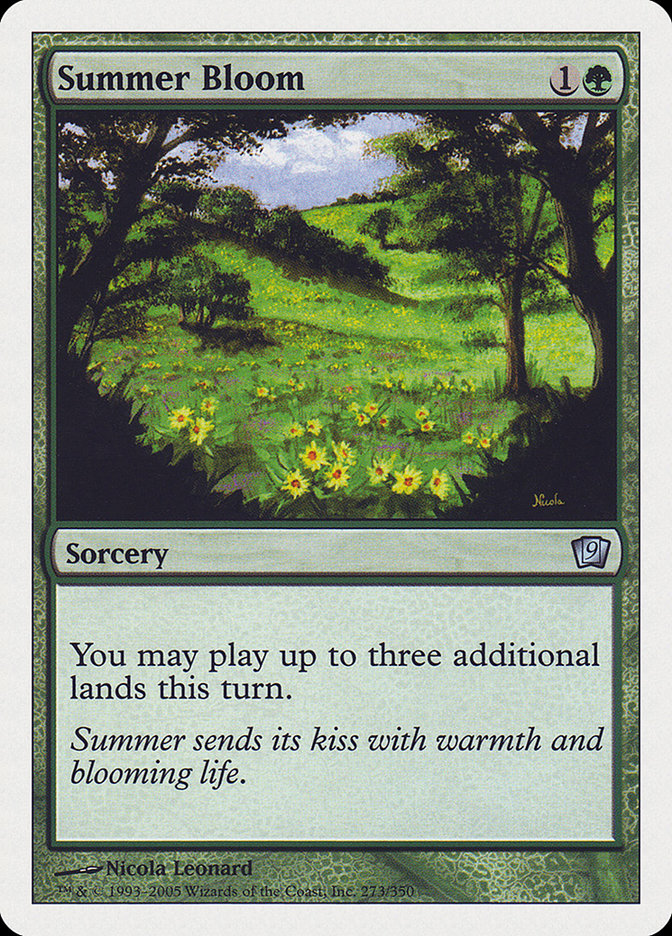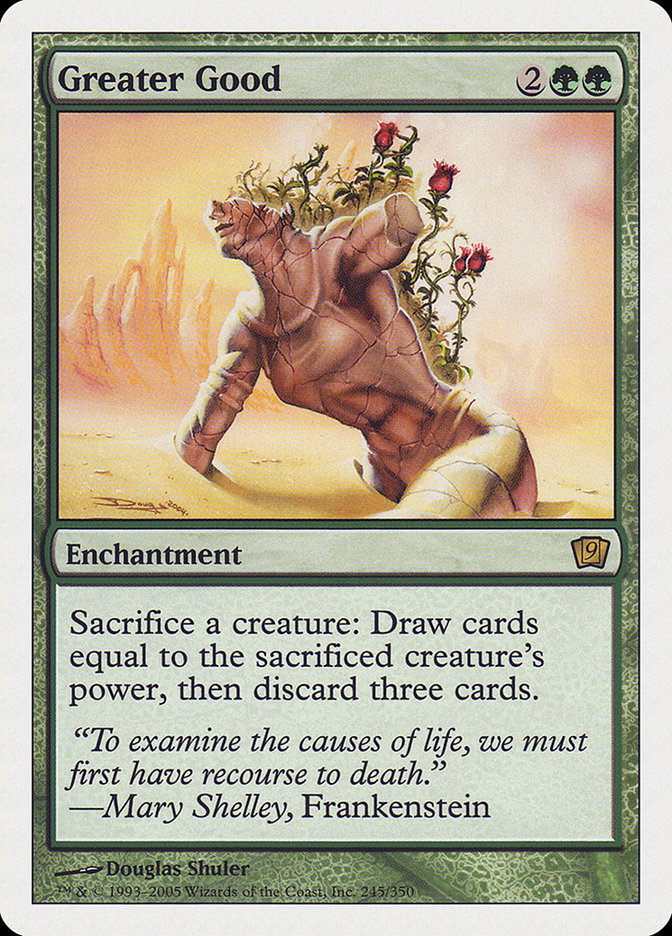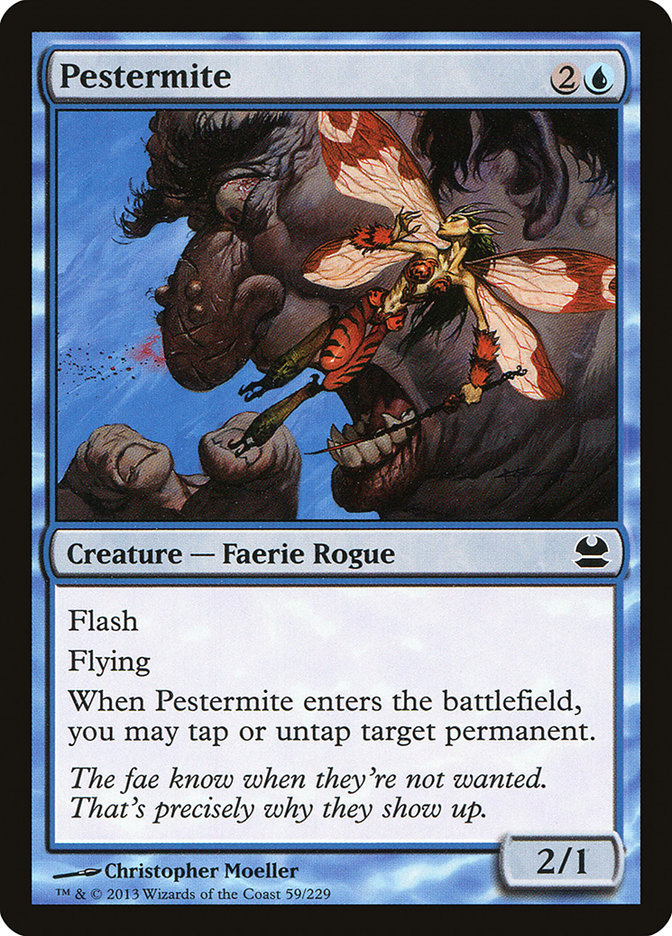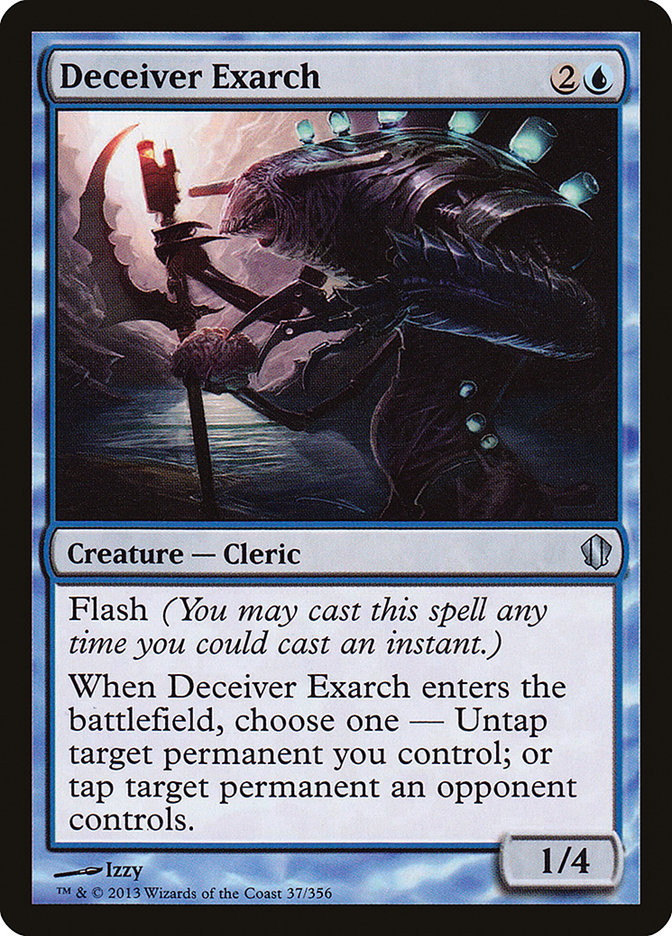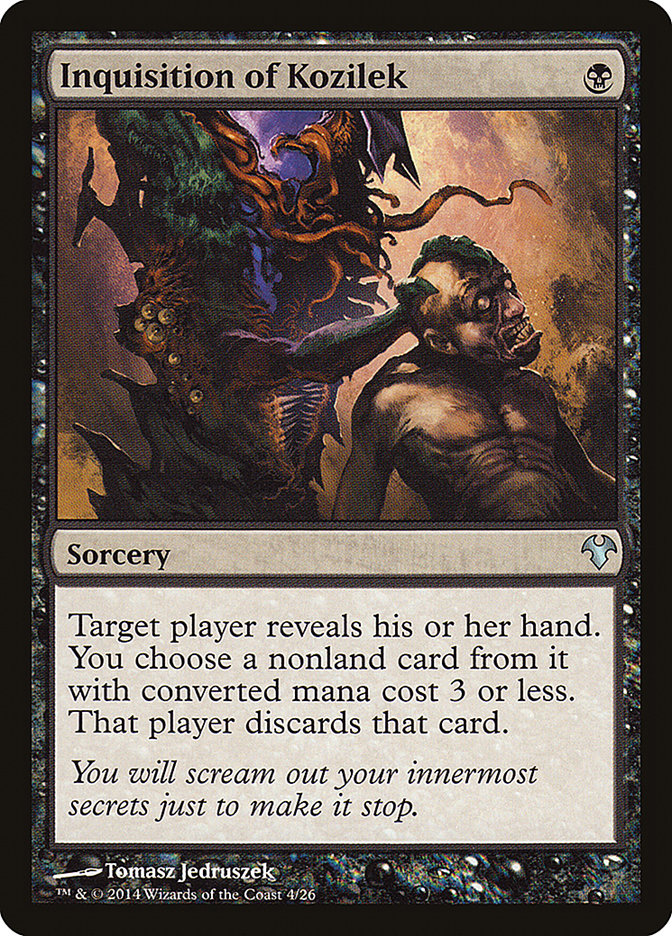On Friday, Wizards accidentally spoiled the Modern Banned List update early, banning Splinter Twin and Summer Bloom. Everyone seemed to expect that some part of the Amulet of Vigor deck would get banned, and most people wanted that to happen, so no one really batted an eye at the Summer Bloom ban, but reactions to the banning of Splinter Twin have been somewhat more varied.
I happen to think both bans made a lot of sense, and I support the decision, even if I might have preferred to see some things unbanned. This weekend, I discussed some of my thoughts on the announcement on Twitter and got a lot of responses and support. This seemed like a topic people are interested in, so I wanted to take time to explain why I think this is a good decision in a format where I can really get into it, rather than little soundbites on Twitter, and try to respond to some of the points I couldn’t get to there.
To lend some credibility to my statements about how I think Wizards of the Coast feels about things, and why they’re doing what they’re doing, I reached out to Erik Lauer for additional insight, so I’ll weave that in as appropriate.
As I wrote in my last article that touched on the subject, Metagaming, Modern is generally in a good place. People at the local level seem to generally enjoy it, as it’s far more popular than Extended used to be, and it has an extremely diverse metagame. I believe these are connected; the less entrenched a player is, the more difficult it will be for them to switch decks regularly. The less they can switch decks, the more they’re subject to getting bored if the experience is too repetitive. In a diverse format, you can play the same deck over and over, feel the accomplishment of learning it really well, and build a personal connection with it, all without getting bored because the games are always different if you’re playing against a wide variety of different decks. It’s very important to WotC to make sure that the format is as diverse as possible to make sure that people can continue to enjoy the format at a local level.
When a card gets banned, it appears to be most damaging to those players, as it might have removed their only deck, which can cause those affected to ask how WotC can possibly be doing this for their interests. The answer is that they’re looking for the best long-term solutions and the best solutions for the most players, not the least bad thing for anyone in particular, and people generally understand that bans are a risk. There’s a concern about consumer confidence, of course, and they don’t want people to always fear that their deck is about to get banned.
Because there wasn’t much talk about Splinter Twin getting banned, a lot of players didn’t see it coming. Some may have thought it was safe because it’d been printed in Modern Masters, and some might have thought it was safe because it’s not really any more successful than it’s always been, and if it was fine before, why wouldn’t it be now? From that perspective, it looks like they’re just trying to ban whatever is most popular just to shake things up. I don’t believe that’s what happened, and I don’t believe that modeling them in that way will be a useful way to predict their future actions.
Splinter Twin was banned because it was too strong and it hurt the diversity of the format. Now, I understand that people disagree with both of those claims, so let me try to defend them, because I think they’re both true.
Remember that for the sake of diversity, Modern needs to not be fair, as explained in my article linked above. Specifically, it has to be the case that the decks with the highest win percentage in the short term need to be decks that the average player can easily figure out how to beat if they’re trying, so that the decks lose popularity when targeted to stop anything from staying at the top. Twin has two Pro Tour wins and eight Top 8 appearances despite being a known presence that everyone built their decks to interact with, and people played dedicated hate for on top of that. Affinity, for example, as a deck some fear might get targeted next as it always has a pretty strong GP Day Two penetration, only has three Top 8s in Modern’s three PTs. Imagine each of these decks as Hall of Fame candidates; they’re not in the same league, and it’s hard to imagine anything catching Twin over the next year. Twin is too resilient and successful for Modern.
Now, as for diversity, it’s easy to claim that Splinter Twin has only been 12%-16% of the format, which really isn’t that bad. It’s hard to figure out the best way to talk about metagame representation, as classifying decks and deciding what events to count are both difficult questions, but as a random example, mtgtop8.com has Twin as twice as played as the second most played archetype (Affinity) in live tournaments over the last two months. So yes, Modern is still diverse, and yes, other formats have had much more dominant decks for much longer without action, but Modern is managed differently from Standard–the fact that it’s non-rotating means that it needs a higher diversity to stay interesting, as explained above, and they’re much more willing to ban cards there than in Standard because it’s an understood part of the format. This means the question is less, “Does this absolutely have to be banned?” (no, Splinter Twin doesn’t) and more, “Would the format be substantially better without this?” (I think so).
There were a few factors outside the raw metagame numbers that made Twin unacceptable. First, it collapses other decks into it–as Erik Lauer put it, we used to have Temur Delver, like what Antonino De Rosa won GP Turin with, but “The amount of Temur hasn’t changed that much over time, but Temur Delver became Temur-Twin.” Similar things happened with Jeskai and Grixis. The package is small enough that it can get spliced into any U/R deck, and because Lightning Bolt and Snapcaster Mage are so good and so good together, that’s a large portion of the format.
The other big issue is that it places massive constraints on the format. I’ve seen people claim that Twin wasn’t keeping anything out of the format. That’s very hard to verify without seeing the format without Splinter Twin–it’s been one of the top decks since the start, so when someone builds a deck and finds that it can’t beat Twin, it often has to get dismissed, so you never see it to know that it’s being pushed out. To put it more concretely, as Erik did, “Splinter Twin smashed the category we usually call ‘other;’ the variety of decks that individually are under 2% of the meta. It moved from ‘combo police’ to ‘fun police’.” All the fringe decks that people tried just lose to the combo, which isn’t surprising; that’s basically what keeps them fringe.
Looking at it more conceptually, rather than by numbers, Splinter Twin forces every deck to be able to interact cheaply and at instant speed, or win before turn 4. Tapping out for anything in the midgame is very risky unless you’ve already cast a discard spell. Functionally, this forced every interactive deck to play cheap instant-speed creature removal, which drastically limits the range on spells people can play. Cards like Wrath of God that are reasonable to imagine as staples of a format like Modern can’t exist because everyone has to play enough spot removal that it doesn’t really make sense to also play sweepers. It was suggested that the only decks that Twin is keeping out are non-interactive decks that are slower than it, but that’s not it. It keeps out any deck based on being resilient, or any deck that doesn’t have the exact right kind of interaction for it.
Now, others raised objection to removing a pillar of the format. If things were all built around Splinter Twin, and it was good, why risk removing that? Erik’s quote above kind of speaks to this. Part of why it has been permitted for so long was because it had been the “combo police.” As an interactive blue deck it could disrupt other combo decks. The hope was that it would beat the unfair decks and lose to the fair decks to try to keep people honest. To quote Erik again:
“But here’s the rub: Splinter Twin stopped being the ‘deck that beat combo decks.’ Grixis Control was better against combo.”
Recently, Grixis Control has beaten combo at a higher rate than Splinter Twin has (I’m just trusting Erik on this one), so they had to ask themselves what Splinter Twin was really doing for the format. If keeping Splinter Twin had been a deal with the devil to get a deck that beat things that needed to be kept in check, it was no longer paying enough dividends to justify the cost to the format in other places, since other decks (or at least another deck) could better accomplish that job anyway.
I’ve seen fears that there will be no place in Modern for blue as a color after these bannings. This is one of those positions that only barely seems worth responding to, but just to be thorough, no, don’t worry, blue will be fine. Every Modern Pro Tour has been won by a blue deck. Blue has won one of the two Modern World Championships and a blue deck finished second in the other one. Obviously, the format is different now. Many of those decks aren’t legal and the others might not be well positioned, but countering spells is almost never an unplayable strategy, and blue still has Snapcaster Mage.
As Erik said, the amount of Temur has stayed consistent as Temur Twin gained popularity; maybe those players will just migrate back to other Temur strategies. Grixis Control has been doing respectably and still exists. Scapeshift could gain stock as the next best Remand deck. I don’t know exactly which blue decks will be on top, and if I did, I wouldn’t say anything about it until after the Pro Tour, but I’m sure all the blue cards other than Pestermite and Deceiver Exarch that were good before will still be good now.
If you didn’t like Modern before, I don’t think these bans will fundamentally change the format. If you were hoping something would, you’re probably disappointed, but you were also deluding yourself. It would be hard to change the fundamental nature of Modern if they wanted to, and given its success, they have no reason to want to. If you played Splinter Twin or you were invested in Splinter Twins, I can understand why you’re unhappy with it, but that doesn’t really speak to how it impacts the health of the format, and, I’d expect that you probably best understood how good it was (unless you played it a lot despite losing with it, in which case, maybe it was time for a change anyway).
The most reasonable cause for concern and some level of, well, something that approaches outrage to me is the fear that you can no longer trust the format as an investment, and that you can’t justify playing it given its cost if your cards could get banned and lose their value at any time. There are no guarantees, and if something needs to go, they’ll ban it. That’s definitely the nature of the format, but my impression is that they really would like to get to the point where they don’t have to ban cards at regular intervals.
Now, obviously, there are concerns here about keeping the Pro Tour “fresh.” So far, they’ve changed the banned list before every PT. They know that Pros and viewers like it when there’s a new format to explore for the Pro Tour, and it can be hard for a single set to change things that much. Well, honestly, if Modern stays as fluid as it’s set up to be, I can imagine the PT not feeling particularly stale despite no changes, and, as someone who’s prepared for all the Modern PTs, I’ve generally felt like there was a lot of exploring to do with each new set. Born of the Gods had a relatively minor impact, but I feel like Oath of the Gatewatch offers enough to have kept things interesting by itself if it had to.
Also, I think WotC’s interested in trying to raise people’s confidence in their cards at this point, and will try to avoid bans unless there’s a real problem before the next PT to help get some of that trust back. I think they’d be more likely to find a card to experiment with unbanning, rather than ban something, if they feel like they need to shake things up next year. It’s possible that part of why nothing was unbanned this time is because the bans were already changing things and they wanted to keep an unban in the holster, though that’s pure speculation on my part.
Now, obviously, the driving forces behind these decisions would be a little different if there weren’t a Modern Pro Tour. The Pro Tour serves to strongly spotlight certain decks, which pushes the metagame to converge (even though it doesn’t always succeed), which is bad. It incentivizes WOTC to try to keep things fresh once a year, which is bad for players who want a stable investment. When they tried to remove the Modern Pro Tour, there was an outcry against that, but this was before the new Standard rotation and block structure was announced and after a Standard that was at the absolute bottom end of the range of diversity in Standard. Moreover, it read as abandoning Modern.
I think it would be great to revisit the issue, possibly with a clearly announced increase in Modern at the Grand Prix level to show support and an understanding of how good the format is for the kind of player that wants to just have one two decks that they can keep playing and slowly tuning for years, which is a reasonable target demographic for GPs.
Personally, I think there are a lot of reasons for players to have their doubts about decisions WotC as a company makes, but I have a lot of faith in Magic R&D specifically. I think the people making the decisions about banning are smart people who know what they’re doing, and have access to information and an understanding of the goals a format is trying to serve that most players don’t have access to. If a change seems bad, I’d advise taking some time with it before locking in a snap judgment.
I’m still early in testing, but I’m hoping the new Modern is awesome, and I’m optimistic.


